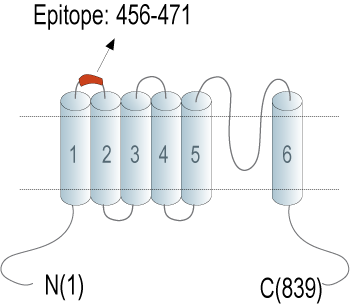Overview
- Peptide (C)RPVDGLPPFKMEKTGD, corresponding to amino acid residues 456 - 471 of human TRPV1 (Accession Q8NER1). Extracellular, 1st loop.

 Western blot analysis of human MCF-7 breast adenocarcinoma cell line lysate (lanes 1 and 4), human LNCaP prostate adenocarcinoma cell line lysate (lanes 2 and 5) and human HMC3 microglia cell line lysate (lanes 3 and 6):1-3. Anti-Human TRPV1 (extracellular) Antibody (#ACC-334), (1:500).
Western blot analysis of human MCF-7 breast adenocarcinoma cell line lysate (lanes 1 and 4), human LNCaP prostate adenocarcinoma cell line lysate (lanes 2 and 5) and human HMC3 microglia cell line lysate (lanes 3 and 6):1-3. Anti-Human TRPV1 (extracellular) Antibody (#ACC-334), (1:500).
4-6. Anti-Human TRPV1 (extracellular) Antibody, preincubated with Human TRPV1 (extracellular) Blocking Peptide (BLP-CC334).
- Gunthorpe, M.J. et al. (2002) Trends Pharmacol. Sci. 23, 183.
- Cesare, P. et al. (1999) Proc. Natl. Acad. Sci. U.S.A. 96, 7658.
- Kim, J. et al. (2003) Nature 424, 81.
- Ahern, G. P. et al. (2003) J. Biol. Chem. 278, 30429.
- Ross, R.A. et al. (2003) Br. J. Pharmacol. 140, 790.
- Tominaga, M. et al. (1998) Neuron 21, 531.
- Vlachova, V. et al. (2003) J. Neurosci. 23, 1340.
- Agopyan, N. et al. (2004) Am. J. Physiol. 286, L563.
- Reilly, C.A. et al. (2003) Toxicol. Sci. 73, 170.
TRPV1 (also named VR1, capsaicin receptor and vanilloid receptor) is a member of the transient receptor potential (TRP) channel family, which includes TRPC, TRPM, TRPA, TRPP, TRPML and the TRPV subfamilies. The TRPV subfamily consists of six members named, TRPV1-6. The TRPV1 channel is a vanilloid gated, nonselective cation channel.
The channel has sequence homology to the TRP family, and shares a similar predicted structure of six transmembrane domain (TM) with a pore loop between TM5 and TM6.1 TRPV1 is expressed predominantly in nociceptors and in sensory neurons.2,3
TRPV1 has many activators among them heat, protons, vanilloids like capsaicin, resiniferatoxin (RTX), and lipids.4 This channel is associated with tissue injury and inflammation.5,6
Other members of this family, TRPV2, TRPV3 and TRPV4 also show thermal sensitivity.7 Conformational changes in the C-terminus are responsible for many functions such as permeation and gating.
There is also evidence that deletion of the C-terminus causes a loss of sensitivity to any stimuli.7 Recent studies demonstrated involvement of TRPV1 in apoptosis where inhibition of the receptor prevented apoptosis.8,9
Application key:
Species reactivity key:
Anti-Human TRPV1 (extracellular) Antibody (#ACC-334) is a highly specific antibody directed against an extracellular epitope of the human protein. The antibody can be used in western blot and flow cytometry applications.
This antibody is not recommended for rat and mouse samples.

